In the Company of Corvids: John Marzluff in the North Cascades
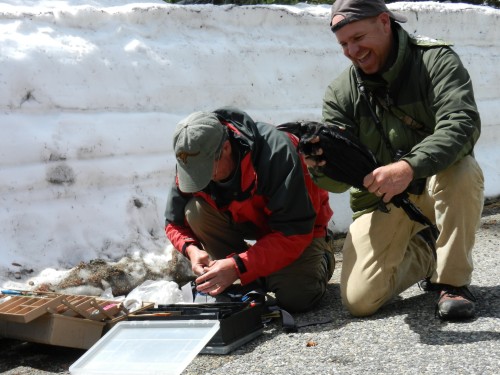
As part of our “Nature of Writing” series, John Marzluff & Tony Angell present Gifts of the Crow: How Perception, Emotion and Thought Allow Smart Birds to Behave Like Humans June 18 at 7pm in the Readings Gallery at Village Books in Bellingham; Free!
This summer, the Environmental Learning Center will be buzzing with adult seminars – from weekend intensives on wild edibles to workshops in watercolor and wildlife tracking, the warmer weather invites opportunities for field learning. From June 1st through June 3rd North Cascades Institute hosted Professor John Marzloff from the University of Washington to share his knowledge and work on corvids, arguably the smartest of the bird families. Marzluff, who has been teaching for the Institute for over five years, continually fills courses to the brim and this year his “In the Company of Corvids” adult seminar was expanded to nineteen eager participants, all excited to spend time in the field searching for ravens, crows, jays, magpies, and nutcrackers.
The weekend began on Friday with introductions and an evening lecture by Marzluff on his work studying crow behavior and information sharing. This evening lecture provided a basis for the weekend’s main focus, field observation and study of corvids in the wild. Both Marzluff and Jack DeLap, a graduate student of John’s also studying ornithology, shared anecdotes about fascinating corvid behavior and highlighted the particularities of the family known to recognize human faces and outwit traps and mazes in order to find food.
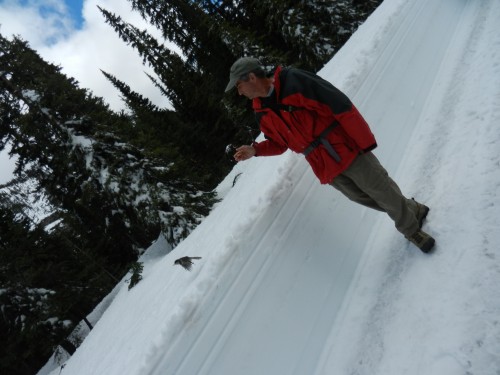
Marzloff attracted gray jays and Clark’s nutcrackers to the group at Washington Pass. Photo by Kiira Heymann.
In an attempt to see each of the corvid species present in the North Cascades, Marzluff took us up to a still snow-covered Washington Pass on Saturday morning. Armed with bait the Institute kitchen had been collecting all week (French toast, pancakes, and old loaves of bread), the group was able to attract gray jays, Stellars jays, and Clark’s nutcrackers within minutes. Marzluff even had birds eating out of his hand, as he attempted to latch onto their feet so that the group might get a closer look at them.
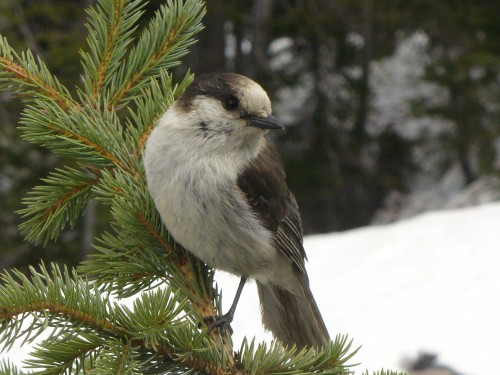
A Gray Jay perches atop a douglas fir while eyeing the bait set out by the group. Photo by Laura Busby.
The tone of the day changed with the arrival of a raven, hovering overhead at first, chasing nutcrackers with scavenged pancakes next, and then finally descending onto our growing pile of breakfast-bait. With her interest peaked, Marzluff and Jack decided to set up the net-gun, a trap that uses the back-end of a rifle to remotely cast a net on the individual to be captured, and wait to see if the raven took the bait. While participants learned more about the adaptations of the Clark’s nutcracker and watched jays swoop down to within inches of their faces, Jack waited patiently to discharge the net. With a gunshot the raven was below the net and the two scientists jumped into action to measure, weigh, and band the bird. Martha (a name aptly chosen considering our capture site at Washington Pass) was banded with blue and yellow anklets and released within minutes. Excitement was buzzing through the group as we loaded back into the buses and headed to the east side to catch glimpses of magpies (an east side specific corvid) and enjoy a sunny walk along the Methow River. The day finished with a film on the exceptional skills exhibited by crows that also highlighted facial recognition studies done at the University of Washington by Marzluff himself.
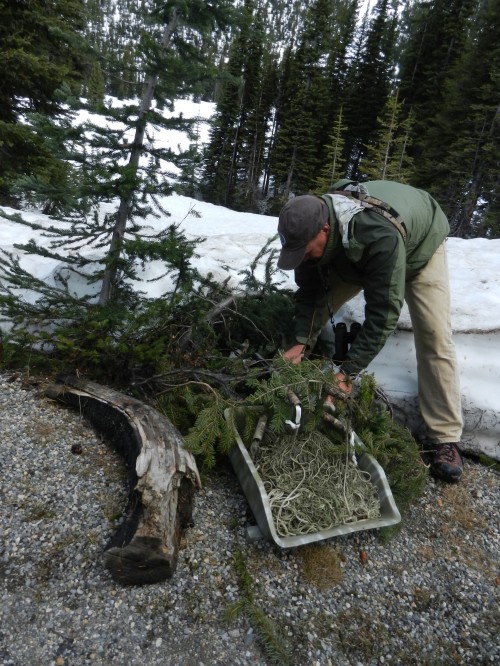
Jack prepares the net gun in anticipation of capturing Martha the raven. Photo by Kiira Heymann.
Sunday was all about Elivs, the Environmental Learning Center’s resident raven. Known for stealing Mountain Schooler’s sack lunches and scavenging through any participant luggage left unattended, Elivs is a lively member of the Institute’s community. Elvis was first caught in June of 2007 by Marzloff during a similar program, but he has avoided other attempts at capture during all successive years that Marzluff’s seminar has been held at the Institute. This time the scene was set just right. On Saturday morning, an inconspicuous black plastic trash bag was left outside of the main office in preparation for concealing the net-gun in the same bag during Sunday morning’s stake out. Though Marzluff also attempted to catch Elvis the morning before by concealing himself under blankets with bait in an open-windowed car behind the dining hall (one of Elivs’ sure-fire scavenging spots) it was the bacon within target range of the net-gun on the final day of the seminar that finally caught the raven. Participants were again able to witness the processing of the bird data, this time with a closer look at the raven inside nearby Trillium classroom. Elvis, who has worn his red ankle band for the five years since his last capture, now also has green and white bands to help participants confirm his identity. The news of Marzluff’s capture of Elvis had all members of the Environmental Learning Center excited. He and his mate, who is not as bold as her partner, have since been spotted flying above campus but have been more wary of food scraps and their potential to deploy trapping nets.
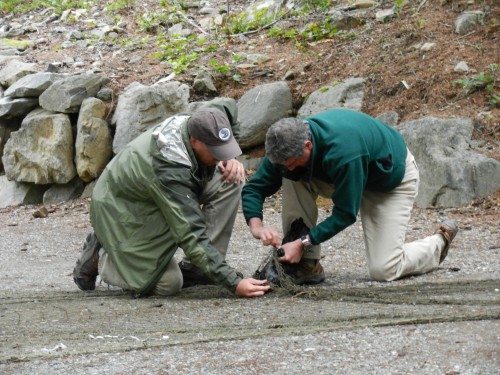
Our resident raven, Elvis, had not been trapped since his original banding in 2007. Here, John and Jack carefully help Elvis from the net before measuring and weighing the bird. Photo by Kiira Heymann.
The course closed with a discussion of proper bird capturing practices, and the ethics of interacting with birds during the scientific process. Marzluff noted that our baiting of the birds was not a practice that should be used outside of work studying corvids, and that conditioning of corvid species to human food sources should not be condoned – Elvis being the perfect example of a bird overly reliant on our community for food. At the same time, participants and Institute staff agreed that the chance to see both Martha and Elvis up close and to watch field science in action was an exceptional experience.
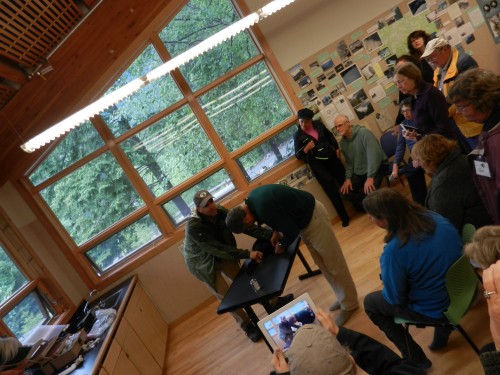
Participants look on as Elvis gets sized up. Photo by Kiira Heymann.
The group visited the North Cascades National Park Visitor’s Center in Newhalem on their way out of town, where Marzluff told stories of yet another raven and his mate – Hitchcock is his name this time – and his uncanny ability to steal windshield wipers from visitor’s cars. We hypothesized as to why ravens might be interested in car parts, and in the process continued to marvel at the complex and interesting behaviors of the birds that had brought us all together for the weekend.
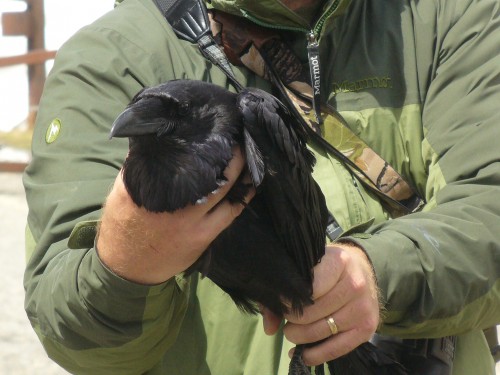
Martha the raven at Washington Pass. Photo by Laura Busby.
For a complete schedule of adult field seminars this season, check out our Learning Center and Field Programs page.


Yesterday at the Diablo Overlook, I saw a huge, beautiful black bird. I don’t know what kind of bird it was but it was much bigger than a crow. As I got closer for a picture, I realized it had a red band on one leg and a green band on the other.
Does anyone know this bird? History?
Thanks
Mike
Hi Mike, Yes I do know this bird! It’s a raven and he is called Elvis. The bands on his legs are from several times when he was caught by John Marzluff and some students. The bands help us keep track of where he goes and other birds that he is in community with. Thanks for your interest and your comment!
Hello,
I was at Diablo Lake today and observed a banded raven. It honed in on my lunch and I was able to feed it a potato chip, common lays variety, i’m sure it enjoyed the high fat content and salt; I know I do. (: I looked around on the internet to figure out who this bird is, and I came across this post. I can only assume I shared lunch with Elvis. Thanks for banding and “taming” the raven. I had a lot of fun with him.
Cheers.